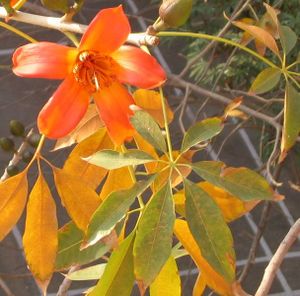Note: This is a project under development. The articles on this wiki are just being initiated and broadly incomplete. You can Help creating new pages.
Bombax ceiba - Kutasalmali
Shalmali is a genus of mainly tropical trees in the mallow family. They are native to western Africa, the Indian subcontinent, Southeast Asia, as well as subtropical regions of East Asia and northern Australia. Distinguish from the genus Ceiba which has whiter flowers.
Currently four species are recognised, although many plants have been placed in the genus that were later moved.
The genus is best known for the species B. ceiba, which is widely cultivated throughout tropical and sub-tropical regions of the world. It is native to southern and eastern Asia and northern Australia.
Uses
semen problems, Leucorrhoea, Over bleeding in menstruation, Acne, skin blemish, pigmentation, Wounds, Cold and cough, Sore throats.
Parts Used
Chemical Composition
Stem and root bark contains lupeol, β-sitosterol, naphthoquinone compound, phenolic substances, a lactone, 4 sesquiterpenes. Root yields triacontanol, β- sitosterol[1]
Common names
| Language | Common name |
|---|---|
| Kannada | |
| Hindi | Shalmali |
| Malayalam | Unnamurika |
| Tamil | Sittan, Sanmali |
| Telugu | Buruga |
| Marathi | NA |
| Gujarathi | NA |
| Punjabi | NA |
| Kashmiri | NA |
| Sanskrit | Shalmali, Semul, Simul |
| English | Silk Cotton Tree, Kapok Tree |
Properties
Reference: Dravya - Substance, Rasa - Taste, Guna - Qualities, Veerya - Potency, Vipaka - Post-digesion effect, Karma - Pharmacological activity, Prabhava - Therepeutics.
Dravya
Rasa
Kashaya (Astringent)
Guna
Laghu (Light), Snigda (haevy)
Veerya
Sheeta (cold)
Vipaka
Madhura (Sweet)
Karma
Prabhava
Habit
Identification
Leaf
| Kind | Shape | Feature |
|---|---|---|
| Simple | Digitate | Leaf Shape is Oblong-lanceolate or elliptic and Leaf Arrangement is Alternate -spiral |
Flower
| Type | Size | Color and composition | Stamen | More information |
|---|---|---|---|---|
| Unisexual | 2-4cm long | Yellow | 5-20 | Solitary, paired or clustered; blood red. Flowering from April-March |
Fruit
| Type | Size | Mass | Appearance | Seeds | More information |
|---|---|---|---|---|---|
| oblong capsule | 7–10 mm | Fruiting April onwards | A loculicidal, oblong capsule, 5-valved | many | {{{6}}} |
Other features
List of Ayurvedic medicine in which the herb is used
- Vishatinduka Taila as root juice extract
Where to get the saplings
Mode of Propagation
How to plant/cultivate
A plant of the tropical, humid lowlands[3]
Commonly seen growing in areas
Photo Gallery
References
External Links
- Ayurvedic Herbs known to be helpful to treat semen problems
- Ayurvedic Herbs known to be helpful to treat Leucorrhoea
- Ayurvedic Herbs known to be helpful to treat Over bleeding in menstruation
- Ayurvedic Herbs known to be helpful to treat Acne
- Ayurvedic Herbs known to be helpful to treat skin blemish
- Ayurvedic Herbs known to be helpful to treat pigmentation
- Ayurvedic Herbs known to be helpful to treat Wounds
- Ayurvedic Herbs known to be helpful to treat Cold and cough
- Ayurvedic Herbs known to be helpful to treat Sore throats
- Herbs with Flowers used in medicine
- Herbs with Leaves used in medicine
- Herbs with common name in Hindi
- Herbs with common name in Malayalam
- Herbs with common name in Tamil
- Herbs with common name in Telugu
- Herbs with common name in Sanskrit
- Herbs with common name in English
- Habit - Deciduous Tree
- Index of Plants which can be propagated by Seeds
- Index of Plants which can be propagated by Cuttings
- Herbs that are commonly seen in the region of Hot, dry river valleys
- Herbs that are commonly seen in the region of at elevations below 1,400 metres
- Herbs that are commonly seen in the region of Humid lowland deciduous forests
- Herbs



